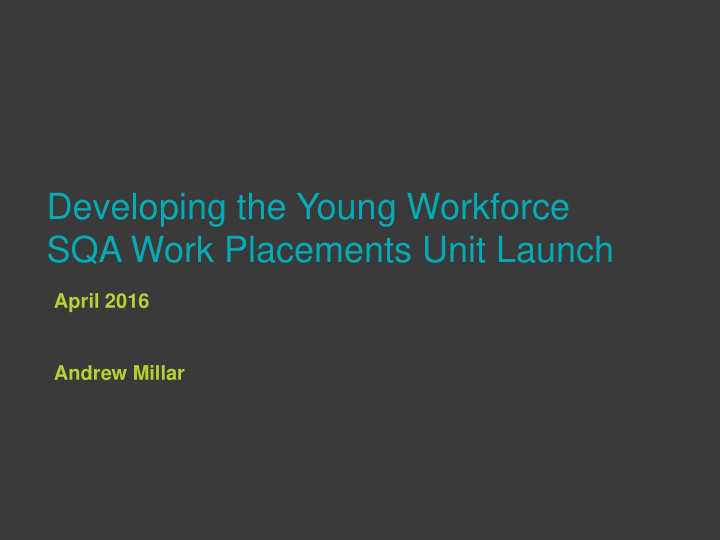



Developing the Young Workforce SQA Work Placements Unit Launch April 2016 Andrew Millar
Overarching Target • To reduce the level of youth unemployment (excluding those in full- time education) by 40% by 2021 • Baseline: 52,000 (Jan-Mar 14). Update June 15
Preparing young people for the world of work Recommendation 3 A modern standard should be established for the acceptable content and quality of work experience , and guidelines should be made available to employers. This should be developed by Education Scotland in partnership with employer bodies and Skills Development Scotland. This should involve input from young people. Work experience should feature in the Senior Phase Benchmarking Tool and in Education Scotland school inspections. Recommendation 33: Career advice and work experience for young disabled people who are still at school should be prioritised and tailored to help them realise their potential and focus positively on what they can do to achieve their career aspirations.
Development of the Work Placements Standard Young Persons Conversation Days (secondary focus) New Cumnock October 2014 & Montrose March 2015 (attended by young people, parents, employers, third sector, school staff and local authority officers/managers, training providers, SDS, Scottish Government, SQA, FE & HE establishments, Education Scotland) Inter-authority World of Work Group – 32 local authority networks of Scottish Council’s Enterprise in Education Network Education Scotland – External Reference Group (Employers, FE, HE) National DYW Group National survey feedback May – July 2015
The standard recognises the rich learning that a young person can experience when o they use and develop their skills in a work environment. It recognises that a work placement should help a young person to make informed o career choices. The standard sets out expectations for the young person, employer, school and o local authority and parent/carer before, during and after work placements The standard sets out expectations for the young person, employer, school and o local authority and parent/carer before, during and after work placements. Implementation of the standard will significantly improve the quality of learning o undertaken in the workplace
Expectations Strong links with Building the Curriculum 4 HGIOS 4: 3.3 Increasing Creativity and Employability – features in Inspection Advice Note for 2015/16 Close co-ordination throughout development with SQA – 2 way process and supporting the development of the new certification following the launch of the WPS Set out before, during and after a placement Clarity for the 4 main partners involved in the success of any work placement: Young person Employer Parent and carer School and local authority
Key Aspects The standard is a universal entitlement – taking account of challenges Structured approach – aids benchmarking and quality assurance Set out to maximise the learning from placements Supports CLPL of staff as new models emerge to share placement learning Supports Career Education of younger students – senior phase students sharing placement learning to younger learners undertaking broad general education Sets out project based working – Workplace Learning Plan
Where are we now? Work on supporting toolkits underway – produced to support implementation: Kibble Education and Care, Dumfries & Galloway, West Lothian, Falkirk and Argyll & Bute Self-evaluation resource available Support for testing new models for work placements via ES representation at WoW Network Sharing models as they emerge: www.educationscotland.gov.uk/developingtheyoungworkforce Inspection Advice & Guidance Note 2015/16: Staff are becoming familiar with the new national draft Standards for Career Education (3-18) and Work Placements, and the guidance on school-employer partnerships Schools are exploring ways to maximise the learning derived from work placements
Andrew Millar andrew.millar@westlothian.gov.uk 01506 283341
Recommend
More recommend